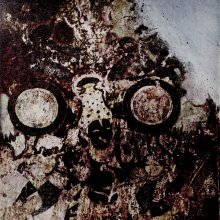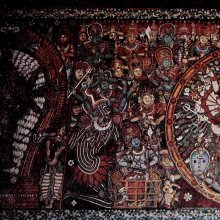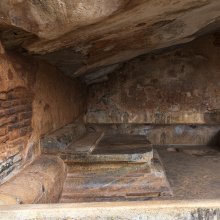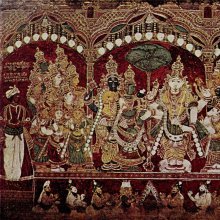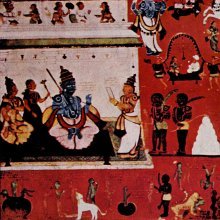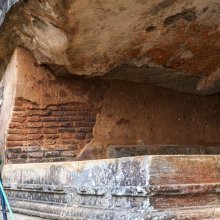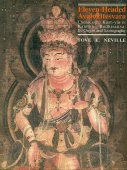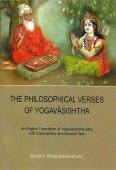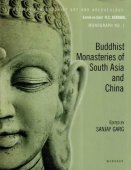Painting: 7 definitions
Introduction:
Painting means something in Hinduism, Sanskrit, the history of ancient India. If you want to know the exact meaning, history, etymology or English translation of this term then check out the descriptions on this page. Add your comment or reference to a book if you want to contribute to this summary article.
Images (photo gallery)
(+254 more images available)
In Hinduism
Purana and Itihasa (epic history)
Source: Shodhganga: Elements of Art and Architecture in the Trtiyakhanda of the VisnudharmottarapuranaPainting (in Sanskrit: Ālekhya) refers to one of the “sixty four kinds of Art”, according to the Kamasutra of Vatsyayana.—Indian tradition, basically includes sixty four Art forms are acknowledged. The history of Indian Art covers approximately five thousand years which presents a rich and almost continuous record. The references of sixty four kinds of Kala (कला, kalā) are found in the Bhagavatapurana, Shaiva-Tantras, Kamasutra of Vatsyayana etc.

The Purana (पुराण, purāṇas) refers to Sanskrit literature preserving ancient India’s vast cultural history, including historical legends, religious ceremonies, various arts and sciences. The eighteen mahapuranas total over 400,000 shlokas (metrical couplets) and date to at least several centuries BCE.
Natyashastra (theatrics and dramaturgy)
Source: Shodhganga: Elements of Art and Architecture in the Trtiyakhanda of the Visnudharmottarapurana (natya)1) Painting of limbs (in Indian Dramas) are included in the Aṅgaracanā division of Āhāryābhinaya: one of the four divisions of Abhinaya or “ways to convey or represent one’s emotion to others”, according to the Viṣṇudharmottarapurāṇa, an ancient Sanskrit text which (being encyclopedic in nature) deals with a variety of cultural topics such as arts, architecture, music, grammar and astronomy.—Aṅgaracanā meaning painting of limbs of different characters, also falls under the category of makeover. The Viṣṇudharmottarapurāṇa speaks that it should be done according to the caste, position, superiority and country of respective characters. [...] The Nāṭyaśāstra says that after painting the face and other limbs the characters are provided with beard according to their territory, profession and spiritual rites.
2) Painting (of lips and feet) is associated with Śīkhara-hasta: one of the twenty-two Single-hand Gestures (in Indian Dramas) (known as asaṃyuktahastas).—The word śīkhara means the peak of a mountain. The Viṣṇudharmottarapurāṇa states that in śīkharahasta, the thumb is lifted in the position of a fist. This posture is used to hold rein, goad and bow. According to the Nāṭyaśāstra, apart from holding rein, goad and bow this posture is used to represent the acting of painting of lips and feet. According to the Nāṭyaśāstra, to show the raising up of hairs, this posture is adopted.

Natyashastra (नाट्यशास्त्र, nāṭyaśāstra) refers to both the ancient Indian tradition (shastra) of performing arts, (natya—theatrics, drama, dance, music), as well as the name of a Sanskrit work dealing with these subjects. It also teaches the rules for composing Dramatic plays (nataka), construction and performance of Theater, and Poetic works (kavya).
Shilpashastra (iconography)
Source: Shodhganga: Elements of Art and Architecture in the Trtiyakhanda of the Visnudharmottarapurana (shilpa)(The Art of) Painting is denoted by the Sanskrit term Citra or Citrakalā, according to the Viṣṇudharmottarapurāṇa, an ancient Sanskrit text which (being encyclopedic in nature) deals with a variety of cultural topics such as arts, architecture, music, grammar and astronomy.—According to the Viṣṇudharmottarapurāṇa, like Dance, in Painting also, the observation of expression of eyes, limbs and all the body parts are very important during portraying a picture on a canvas. In the Kāmasūtra, Vātsyāyaṇa mentions about the six limbs (ṣaḍaṅga) of Painting through the combination of which an art could be complete and flawless.

Shilpashastra (शिल्पशास्त्र, śilpaśāstra) represents the ancient Indian science (shastra) of creative arts (shilpa) such as sculpture, iconography and painting. Closely related to Vastushastra (architecture), they often share the same literature.
India history and geography
Source: archive.org: Bharatiya vastu-sastra (History)Painting in Ancient India, according to M. Foucher (Beginning of Buddhistic Art).—“From the Vedic times, Indian civilization had at its disposal the services not only of the carpenter, the wheelwright and the blacksmith, of the potter, the weaver and the fabricators of objects of prime necessity but also of those whom we call art-workers, painters, goldsmiths, carvers in ivory or wood etc.”.
Source: Singhi Jain Series: Ratnaprabha-suri’s Kuvalayamala-katha (history)Painting (scroll-designs) on the floor, refers to one of the tasks performed to beautify the Sleeping chamber (of young ladies) in Ancient India, as depicted in the Kathās (narrative poems) such as Uddyotanasūri in his 8th-century Kuvalayamālā (a Prakrit Campū, similar to Kāvya poetry).—The Kuvalayamala (779 A.D.) is full of cultural material which gains in value because of the firm date of its composition. [...] Page 83.3-9: Here is the description of the house or the sleeping chambers of young ladies which were beautified for the reception of their husbands. The select items in this list are as follows: [e.g., painting scroll-designs on the floor (koṭṭime pattalayāo);] [...]
Source: Shodhganga: Elements of Art and Architecture in the Trtiyakhanda of the Visnudharmottarapurana (history)Painting in ancient India can be traced to the pre-historic period.—In the evolution of Indian Painting, the history of Painting of Indus Valley Civilization bears an important role. [...] The Paintings of the caves of Ajanta also represent the Paintings of Buddhist period. These Paintings represent the past lives and the rebirth of Buddha, symbolic tales from Āryacūra’s Jātakamālā and rock sculptures of the Buddhist deities. [...] Apart from it, if the discussion of evolution of Painting in India is done through the lens of the Vedic and Classical Sanskrit literature, a vast range of development can be seen till the date of the Viṣṇudharmottarapurāṇa.
[The art of painting] had been continuing through the ages of the Rāmāyaṇa and the Mahābhārata. [...] The texts of classical Sanskrit literature bear numerous examples of the practice of this great art form. Poets like Bhāsa, Kālidāsa, Bhavabhuti etc. decorated their literary pieces with many beautiful descriptions which sometimes appear as beautiful pictures in front of the readers. Thus the concept of citrakāvya appeared in this way. [...] Thus the concept of Painting has remained a source of depiction throughout the ages.
Source: Shodhganga: Elements of Art and Architecture in the Trtiyakhanda of the Visnudharmottarapurana (history)(The History of) Painting in ancient India can be traced to the pre-historic period.—In the evolution of Indian Painting, the history of Painting of Indus Valley Civilization bears an important role. [...] The Paintings of the caves of Ajanta also represent the Paintings of Buddhist period. These Paintings represent the past lives and the rebirth of Buddha, symbolic tales from Āryacūra’s Jātakamālā and rock sculptures of the Buddhist deities. [...] Apart from it, if the discussion of evolution of Painting in India is done through the lens of the Vedic and Classical Sanskrit literature, a vast range of development can be seen till the date of the Viṣṇudharmottarapurāṇa.
[The art of painting] had been continuing through the ages of the Rāmāyaṇa and the Mahābhārata. [...] The texts of classical Sanskrit literature bear numerous examples of the practice of this great art form. Poets like Bhāsa, Kālidāsa, Bhavabhuti etc. decorated their literary pieces with many beautiful descriptions which sometimes appear as beautiful pictures in front of the readers. Thus the concept of citrakāvya appeared in this way. [...] Thus the concept of Painting has remained a source of depiction throughout the ages.

The history of India traces the identification of countries, villages, towns and other regions of India, as well as mythology, zoology, royal dynasties, rulers, tribes, local festivities and traditions and regional languages. Ancient India enjoyed religious freedom and encourages the path of Dharma, a concept common to Buddhism, Hinduism, and Jainism.
See also (Relevant definitions)
Ends with: Cloth-painting, Indian painting, Wall painting.
Full-text (+1376): Citra, Alekhya, Lipi, Alekhana, Citraphalaka, Pustakarman, Citrakarman, Varnana, Sadrishya, Citrapata, Indian painting, Satya, Dagaduji, Citralikhana, Water, Dagadoji, Tanjore, Bhitti-citra, Ullekhana, Bhava.
Relevant text
Search found 185 books and stories containing Painting; (plurals include: Paintings). You can also click to the full overview containing English textual excerpts. Below are direct links for the most relevant articles:
Vishnudharmottara Purana (Art and Architecture) (by Bhagyashree Sarma)
5. The Viṣṇudharmottara-purāṇa and the Modern Paintings < [Chapter 6 - Modern Relevance of Different Art Forms and Architecture]
1. Painting: The Concept < [Chapter 5 - Painting and Image Making]
7(h): Connection of Sentiments with the Paintings < [Chapter 5 - Painting and Image Making]
Parables of Rama (by Swami Rama Tirtha)
Story 221 - The King and two painters < [Chapter XLI - Purity]
Story 84 - Two ways of Acquiring Knowledge < [Chapter XI - Mind]
Story 82 - How to Acquire All Knowledge < [Chapter XI - Mind]
Scientist Painters < [January – March, 2003]
Indian Painting < [April – June, 1987]
Dr Coomaraswamy as an Interpreter of Rajput Painting < [July – September 1977]
Harshacharita (socio-cultural Study) (by Mrs. Nandita Sarmah)
16.1. Drawing and Painting < [Chapter 6 - Other Socio-Cultural Aspects]
1. Similarities (8): Art and Architecture < [Chapter 8 - Comparative Society as described in the Kādambarī and the Harṣacarita]
Part 4(b): Bāṇabhaṭṭa: His Style of Writing < [Chapter 1 - Introduction]
Middle Chola Temples (by S. R. Balasubrahmanyam)
Parivaralayattu Pillaiyar < [Tanjavur/Thanjavur (Rajarajesvaram temple)]
Temples in Tirumalai < [Chapter II - Temples of Rajaraja I’s Time]
Samarangana-sutradhara (Summary) (by D. N. Shukla)
Related products
(+1 more products available)
